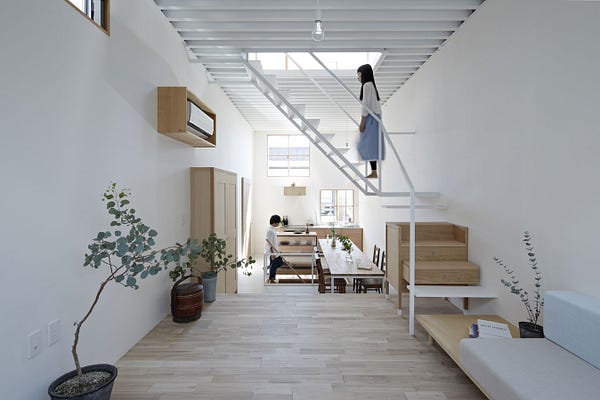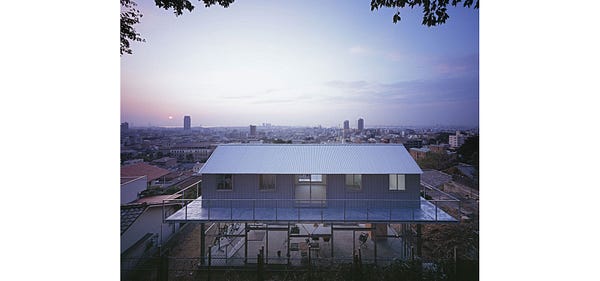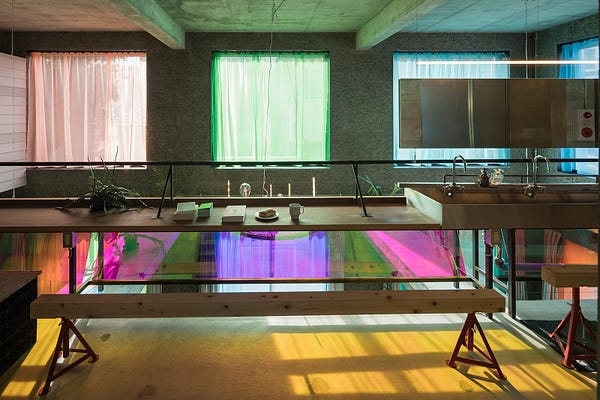The Butterfly Effect: Yo Shimada on Dynamic Abstractness
By Staff Writer Cameron Lee ’22
Initially, I have difficulty finding Yo Shimada. Perched on a stool behind the speaker’s podium at the forefront of the dimly lit, densely packed lecture hall, the Japanese architect attracts very little attention to himself. He is dressed modestly in a simple white button-up, and when he begins to speak, his gentle voice barely floats above the soft murmurs in the background. Sometimes, I have to strain my ears to hear him say certain words. Yet despite his humble, unassuming appearance, he emits such immense command over his artwork, using verbal language frugally and instead relying on the beauty and absurdity of his creations to captivate the audience.

Figure I: House in Itami
, courtesy of Tato Architects; Photo by Koichi Torimura
On October 1st, 2018, Shimada was invited to speak at Princeton as a part of a lecture series organized by the School of Architecture. However, Shimada himself never received formal architectural or design training — during his years as a student he attended art school, never intending on becoming a freelance architect. Rather, he felt compelled to start his architectural firm, Tato Architects, in a moment of inspiration while residing in his house located within the mountains of Kobe. The peaceful isolation and simplicity of his mountain home allowed him to feel grounded and connected to the nature surrounding him, a feeling that he now seeks to replicate in his current architectural projects. Upon viewing several images of Shimada’s compositions for the first time, I immediately noticed the fresh, raw, natural energy his designs seemed to exude, especially apparent in the simplistic beauty and vitality of the House in Itami (Figure I). The white walls and vast skylights and windows seemed to illuminate the building with natural light, invoking the pure crispness and healing power of early morning when the evening frost has just begun to turn to dew. I also loved how the delicate, bird-bone structural detailing and the exposed maple wood seemed to bring elements of the outdoors directly within the home, joining together nature and design in harmonious union.
With his unconventional mentality towards architecture, Shimada embodies the spirit of an artist, just as much as he has the eye and intuition of an architect — he treats architectural design more as an abstract form of sculpture, rather than a formula or an algorithm. His compositions merge traditional Japanese interior design aesthetics with the minimalism and efficiency of modern design, culminating in a style that exudes elegance, simplicity, nostalgia, and rusticity all at once. In many ways, Shimada’s ingenious melding of the old and the new reflects qualities of the greater Japanese culture, which has similarly found a way to balance modernization in the digital age with maintaining a deep appreciation for craftsmanship, detail, and artisans. With just the right combination of old and new ingredients, Shimada’s style presents something very novel in the landscape of architecture, while retaining a level of intimacy and familiarity that excites something almost primal within the observer.

Figure II: House of Rokko
, courtesy of Tato Architects; Photo by Ken’ichi Suzuki
Shimada shared several of his personal philosophies surrounding architecture, referencing several of his own projects as case studies. As a bystander of a culture that churns out “cookie-cutter houses” for the sake of profit and appeasement, I found Shimada’s outlook towards architecture fresh, inspiring, and even a bit utopian. When faced with a new project, Shimada takes only two factors into consideration: the specific requests and needs of his client, and the surrounding environment of the building’s location. Shimada believes in the possibility of merging architecture with nature, and argues that architects should design buildings that cater to the specific environment of the building site. He asserts that while designing a building, it is important to consider the surroundings, condition of the site, climate, nature etc. to ensure that the final construction is in harmony with the environment. Many of his projects exhibit traces of this mindset, such as the House of Rokko which is elevated on pillars to pay homage to the high elevation of the location site (Figure II). Additionally, the simplicity of the design and building materials is an intentional choice that shows, “no prejudice towards the environment.” In contrast, Shimada’s project House in Sonobe brings nature inside the home, by providing a central garden in one of the family rooms in the house. Aside from nature, Shimada also considers the history of the city he is building in as a part of the environment. His hotel project, The Blend Inn, was built in an artist’s town, so Shimada chose to collaborate with several of the artists residing in the neighborhood to include their artwork and style in his hotel rooms (Figure III).

Figure III: The Blend Inn
, courtesy of Tato Architects; Photo by Shinkenchiku sha
Shimada stated that he wants to spark a cultural revolution within the world of architecture and design, in what he calls the “butterfly effect.” By this, he means that there must be a metamorphosis within the mindset of architects, moving away from their current reckless disregard for nature and towards a fluid appreciation and respect for nature. As a result of this shift, the architect and the environment coexist peacefully rather than forcefully. In this frame of mind, he indirectly criticizes modern-day architects for lacking creativity and abandoning quality in favor of quantity, possibly hinting at an “architectural awakening.” Individuality and absurdity are characteristic of Shimada’s work, something that Shimada himself seems very proud of; even something as simple as his business cards stand outside the norm — he chooses to format his business cards as receipts, rather than on a traditional rectangular slip of paper. In a world where everything moves quickly and unforgivingly, Shimada’s work and philosophy are important reminders to stop and reflect on the importance and beauty of nature and the spaces we inhabit.